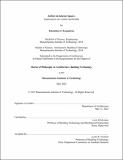Airflow in Interior Spaces: Implications on Comfort and Health
Author(s)
Kongoletos, Johnathan J.
DownloadThesis PDF (11.08Mb)
Advisor
Glicksman, Leon
Terms of use
Metadata
Show full item recordAbstract
The International Energy Agency projects that rising income and greater access to air conditioning equipment in many developing countries will increase CO₂-equivalent emissions, energy consumption, and urban heat island effects. India exhibits these traits, where new building trends, hot climatic conditions, increasing social aspirations, and rapid population growth is likely to spread the adoption of air conditioning. Within India, while air-conditioners are attainable, the financial cost of acquisition and operation preclude their usage by the population’s most vulnerable. To reduce the need for air conditioning and increase available building options, low cost and socially-acceptable options are necessary to reduce productivity losses and excess mortality.
This work presents the results of long-term temperature monitoring within four occupied homes, builds a model for understanding the influence of material choice, and evaluates that model on the basis of a reduction in peak indoor air temperature and energy savings as compared to an equivalent air conditioner. Results from the occupied homes show a peak reduction in inside air temperature of 8.2 °C during the summer months relative to informal housing in the same community. Further, using scale models and input from the Ramdev Nagar community in Bhuj, the impacts of operational airflow changes are quantified with a focus on next-day thermal comfort. Applicable outside of India, the techniques can be used concurrently with active cooling systems to reduce energy consumption or extend capacity. Targeting near-term implementation in India, this work focuses on tangible improvements spanning construction and operation.
Shifting towards offices using chilled beams, this work presents data on the impact of ceiling fans on chilled beam performance both in steady-state and in transient situations to address discomfort in conference room settings where rapid changes in cooling performance are required or capacities exceeded. This work extends on that theme to propose improved thermostat placement targeting the reliability of the thermostat readings to serve as a proxy for thermal comfort.
Finally, this work looks at dispersion of bioaerosols within a classroom environment. Via simulations, this work contributes through the quantification of different ventilation approaches and generalizable recommendations for contaminant control at the breathing zone.
Date issued
2022-05Department
Massachusetts Institute of Technology. Department of ArchitecturePublisher
Massachusetts Institute of Technology